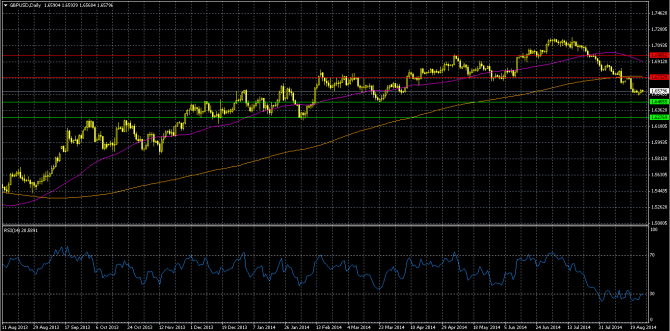Janet Yellen stated that even though recent labour market data (unemployment rate: 6.2%) shows improvement, there still exists spare capacity in the economy. Thus, we expect the Fed will introduce the interest rate hike in mid-2015 due to an improving labour market and to combat rising inflation.
In addition, more data is required to justify an interest rate hike. An early interest rate hike will cause a drop in consumer expenditure and a lack of capital expenditure from firms. This could effectively derail the current recovery. If they delay the interest rate hike then they could risk having high inflation.
Soft inflation data from the UK (CPI y/y data, Actual: 1.6%, Forecast: 1.8%, Previous: 1.9%, 19/08/2014) has decreased the chances of an earlier rate hike. The BoE also need more data to assess when an interest rate hike can be implemented. The BoE are likely to be the first bank amongst the Fed and ECB to raise interest rates. In addition, investors should be happy as at the last meeting 2 BoE committee members voted in favour of a rate hike, whilst 7 voted to hold the current interest rate at 0.5%. This signals that the current members are thinking of a near term rate hike by the end of 2014. In addition the rate hike will be gradual and fairly limited. One of the major concerns for the BoE is wage growth. Wage growth (Average Earnings Index 3m/y, Actual: -0.2%, Forecast: -0.1%, Previous: 0.4%, 13/08/2014) has been stagnant and is below the inflation rate which is causing financial pressure on families. Thus, the problem can be sorted by firms boosting productivity, which will increase wages for employees. Wage growth is one of the indicators the BoE will be looking at when deciding on the rate hike.
| Support 2 (S2) | Support 1 (S1) | Current Price | Resistance 1 (R1) | Resistance 2 (R2) |
| 1.62769 | 1.64555 | 1.65796 | 1.67329 | 1.69852 |

The pair is currently in a downtrend. We have identified R1 to be a strong ceiling for the pair, the pair has tested this level once and the pair has failed to break it. R2 is also a strong ceiling for the pair, the pair has tested this level once and the pair has failed to break it.
S1 is a strong floor for the pair, the pair has tested this level once and the pair has failed to break it. S2 is also a strong floor for the pair, the pair has tested this level three times and the pair has failed to break this level.
Technicals: RSI (Relative Strength Index) and MAs (Moving Averages)
- RSI is currently in oversold region, there may be a pull back to 1.66790 to further continue the downtrend.
- 200-day MA (orange) has flat lined and 50-day MA (magenta) is in a downtrend signalling a bearish stance for the pair. In addition, 200-day MA and 50-day MA will provide additional resistance to the pair.
In the short-term the pair is bullish. When tapering ends in October for the Fed there is great uncertainty of what will happen to US stock markets. In addition, they are probably going to be the second central bank amongst the BoE and ECB to raise rates. Thus uncertainty and timing of the rate hike will play negatively on the greenback for some time. The UK economy is doing very well, the only major concern is wage inflation, which only the firms can have an impact on.
CFDs, spread betting and FX can result in losses exceeding your initial deposit. They are not suitable for everyone, so please ensure you understand the risks. Seek independent financial advice if necessary. Nothing in this article should be considered a personal recommendation. It does not account for your personal circumstances or appetite for risk.
Guest post by Ajay Pankhania of Accendo Markets
